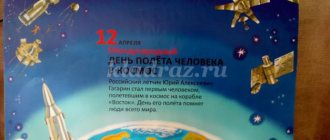Exciting experiments with magnets for children with explanations
We suggest considering experiments with magnets using ingenuity and ingenuity. For example, heat has a destructive effect on magnetic properties.
With a candle
We also propose to refute the theory that only iron is subject to magnetic influence. An exception is, for example, matches.
With matches
Let's improve the theory about the strength of a magnet a little.
Magnetic gun
We suggest creating a magnetic mechanism with your own hands.
Experiment
Using a similar algorithm, you can try different shapes of wire.
Rotation under magnetic influence
Or you can make a homemade fan! By the way, if you change the pole that touches the magnet, the direction of movement of the wire will change.
Experiment
Or you can make such an engine with your own hands.
Engine
And finally, create an almost perpetual motion machine from a magnet, a battery and copper wire (if you close the wire in a circle). Until the battery runs out. All these experiments operate on the principle of a simple electric motor - electrons move along a wire, and a force acts on them.
Magnetic train
Don't be afraid to experiment - experiments with magnets are so exciting and varied that they can surprise even adults.
Educator: Shall we help, guys? (Yes)But to help Nolik, we need to go to the laboratory. Are you ready? (Yes)
To go to the laboratory, we need to stand in a circle and say the magic words, I will speak, and you repeat after me:
1, 2, 3, 4, 5 – Let’s start casting spells!
Crabble, crabble, boom!
Our children are spinning -
found ourselves in the laboratory
(The children end up in the laboratory where Nolik meets them)
Nolik: Hello guys, thank you for coming to help. What do we do? (Figure out how to quickly find metal parts.)
Nolik: Dedus told me that iron parts can be attracted using a magnet, but I don’t know what “Magnet” is. Guys, do you know what a magnet is? (children's answers)
Educator: Nolik, guys, don’t worry, to find out better what a “magnet” is, we need to watch an instructive presentation and listen to my story. Sit down on the chairs, pay attention to the screen. (children view the presentation).
Educator: Well, guys, now you know what a magnet is? (Yes, children's answer options)
“Here in front of you is an ordinary magnet. He keeps many secrets within himself.” — What do we know about the properties of a magnet? — How can these properties be checked? So we'll check it now. “The important thing is Experiment! Every moment of it is interesting to us.”
Where do experiments usually take place? (Children's answers)
Tell me who works in the laboratory? (Scientists, laboratory assistants, researchers) Guys, let’s be scientists ourselves and study the properties of a magnet. We need to put on robes. (Children wear dressing gowns). Educator: How should you work in the laboratory? (be careful, take your time, listen carefully, don’t push and keep quiet.)
Experiment No. 1 Look at the glass of water on the table; at the bottom of the glass of water there is a paper clip. You have to get it out without getting your hands wet. Nolik: How will we complete this task? What do we do? Educator: Let's run a magnet along the glass and lift the paper clip above the water. Educator: Why were we able to lift it? (Children's answers) Educator: That's right, magnetic forces pass through both glass and water.
Experiment No. 2 On everyone’s table there is a cardboard field with flowers and a butterfly on a magnet. We need to help the butterfly fly from one flower to another flower without touching the butterfly with your hands.
Nolik: How to do this without hands? How to complete this task? Educator: Place a magnet under the cardboard and move it towards the flower. (Children perform the experiment) Educator: Were we able to complete the task? What can you say about magnetic force? (The magnetic force also passes through cardboard.)
Educator: I see that you are a little tired. I invite you to stand around and relax and play. Musical physical exercise: “Fixies One Two Three
Four Five Fixik went out for a walk"
Experiment No. 3 Look at the box of cereal on the table where the iron objects are hidden. We need to find them without our hands.
Nolik: You can find them with a magnet! How do we complete this task? (Children's expected answers) Educator: Let's hold the magnet over the objects. Let's do it. What happened? (Children's answers)
Why are iron objects attracted to a magnet? (Children's answers)
Magnetic forces pass through the grain. (Children's answers)
Nolik: (Looks at the details) Oh, guys, among the parts found in the cereal, my lost parts were also found, apparently Nipper threw them into the box with the cereal. You guys are great! Look, your magic stone really helped me, I found the details.
Thanks guys for your help. I learned a lot of useful and interesting things from you. Now I will assemble the robot. I want to thank you for your help. I have a constructor. I give it to you. Educator: Thank you Nolik too. It's time for us to go back to kindergarten. Let's say the magic words:
1, 2, 3, 4, 5 – Let’s start casting spells!
Crabble, crabble, boom!
Our children are spinning -
We found ourselves in kindergarten.
Educator: Guys, let's summarize our journey to Nolik's laboratory.
What did we learn today?
(The magnet attracts iron.
The magnet acts through the paper.
The magnet acts through the glass.
Under the influence of a magnet, metal objects are magnetized and become magnets themselves for a short time. Using a magnet, you can quickly separate iron from other materials.)
Guys, tell me, and we meet with a magnet in a group, where we see its magical properties (DI: “Magnetic Mosaic”, “Magnetic ABC”, “Fisherman”, attaching pictures to the board).
Educator: Thank you guys, you’re great!
Studying the use of magnets in people's lives
Goal: Find out where magnets are used.
Progress of the research: searching for information about the use of magnets on the Internet
People learned about magnets a long time ago and began to use its properties for their own purposes. In all branches of life, a magnet is a constant companion.
1. The first device based on the phenomenon of magnetism was the compass. It was invented in China, approximately between the 4th and 6th centuries.
2. Due to the property of magnets to act at a distance and through solutions, they are used in chemical and medical laboratories, where it is necessary to mix sterile substances in small quantities. Magnets are used underwater. Due to their ability to attract objects underwater, magnets are used in the construction and repair of underwater structures. With their help, it is very convenient to secure and lay a cable or keep a tool at hand.
3. Magnets are used for medicinal purposes in the form of patches, bracelets, amulets, because they have a mild analgesic effect, improve mood, treat bone diseases, reduce the excitability of the nervous system and relieve stress.
4.The magnetic method of removing metal particles from the eye is widely used.
5. Magnets surround us everywhere, since all the devices we use in everyday life, one way or another, include magnets - mobile phones, computers, cabinet doors, stereos, electric motors, cars, displays, compasses, toys, a variety of sensors and instruments, research equipment and many other areas.
Conclusion
Our hypothesis was confirmed. After conducting our research, we found out that magnets have many properties:
1. Magnets have the ability to attract objects made of iron or steel. Wood, plastics and paper do not react to magnets.
2. Magnets with the same poles repel, and magnets with different poles attract.
3. Magnetic force can pass through objects and substances.
4. Magnets attract even from a distance. The larger the magnet, the greater the force of attraction and the greater the distance over which the magnet exerts its influence.
5. Not all magnets are the same, different magnets have different strengths, this strength depends on the size of the magnet.
6. A magnet can transfer its properties to other objects, temporarily turning them into magnets;
7. Magnets with like poles repel each other;
There is no area of human activity where magnets are not used.
During our research, we learned a lot of interesting things about magnets:
In 2006, Pierre Proske and his colleagues at the Future Applications Lab in Sweden invented unique magnets that are equipped with 16-character LCD displays and can interact with each other while hanging on the refrigerator. If you hang two or more magnets next to each other, the devices themselves will check the word order and correct grammatical errors, a kind of Word editor for the refrigerator door.
Soon a new generation of devices will come into use - magnetic gadgets, which, in essence, are a mini-computer on the refrigerator door. Gadgets transmit text and voice messages, make a list of necessary products and even calculate the energy value of food.
There is a Guinness Museum in Hollywood that displays over 7,000 magnets (part of the Louise Greenfarb collection).
Card index of experiments and games with magnets
Table of contents
PART 1. EXPERIMENTS AND EXPERIMENTS WITH MAGNETS
……………………………………………………………………………………………….. 4
EXPERIMENT 1. WHAT MATERIALS DOES A MAGNET ATTRACT?…………………………………………………………………………………………………………………………………….. 4
EXPERIMENT 2. MAGNETS ACT AT A DISTANCE……………………………………………………………………………………………………………………. .6
EXPERIMENT 3. A MAGNET HAS TWO POLES…………………………………………………………………………………………………………………………………………… ……………… 8
EXPERIMENT 4. HOW TO SEE THE MAGNETIC FIELD? ………….. 9
EXPERIMENT 5. MAGNETIC PROPERTIES CAN BE TRANSFERRED TO ORDINARY IRON……………………………………………………………………………………………… 10
EXPERIMENT 6. MAGNETIC FIELD OF THE EARTH…………………………………………………………………………………………………………………… ……………….. eleven
PART 2. GAMES WITH MAGNETS
……………………………………………………………………………………………………………………………………. 12
MAGNETIC PUPPET THEATER……………………………………………………………………………………………………………………………………………… ……….. 12
VOLUMETRIC LABYRINTH…………………………………………………………………………………………………………………………………………………… ………………………. 15
PICTURE MAZE “CAT AND MOUSE”…………………………………………………………………………………………………………………………………………… ….. 16
PENCIL POINT-MAGNETIC CONSTRUCTOR ON A CAN……………………………………………………………………………………………………………………………………. 18
FUNNY KNOCKS……………………………………………………………………………………………………………………………………… ……………………………. 19
CONCLUSION………………………………………………………………………………………………………………………………… ……………………………………. 21
3
What do we know about magnets?
Searching for information in the encyclopedia.
Purpose of the study: to find out how magnets appeared
Result.
A magnet is a body that has its own magnetic field.
A magnetic field is the area around a magnet, within which the influence of the magnet on external objects is felt.
Magnetic force is the force with which objects are attracted to a magnet.
Magnet (from Greek - stone from Magnesia - an ancient city in Asia Minor) - a natural magnet - a piece of iron ore that has the property of attracting iron, steel, cobalt, etc. and has its own magnetic field. It has been known to man since ancient times.
An ancient legend tells about a shepherd named Magnus. In search of a sheep, the shepherd went to unfamiliar places, into the mountains. He noticed with amazement that the iron tip of his stick was attracted to the black stone. Moreover, it was necessary to rub the blade of a knife with such a stone, and it itself began to attract iron objects: nails, arrowheads.
It was as if some kind of power, mysterious, of course, flowed into them from a stone brought from the mountains. This stone came to be called the “Magnus Stone” or simply “the magnet.”
Thus, many centuries BC it was known that some stones could attract pieces of iron. This was mentioned in the 6th century BC by the Greek physicist and philosopher Thales. The first scientific study of the properties of a magnet was prescribed in the 13th century by the scientist Peter Peregrinus.

